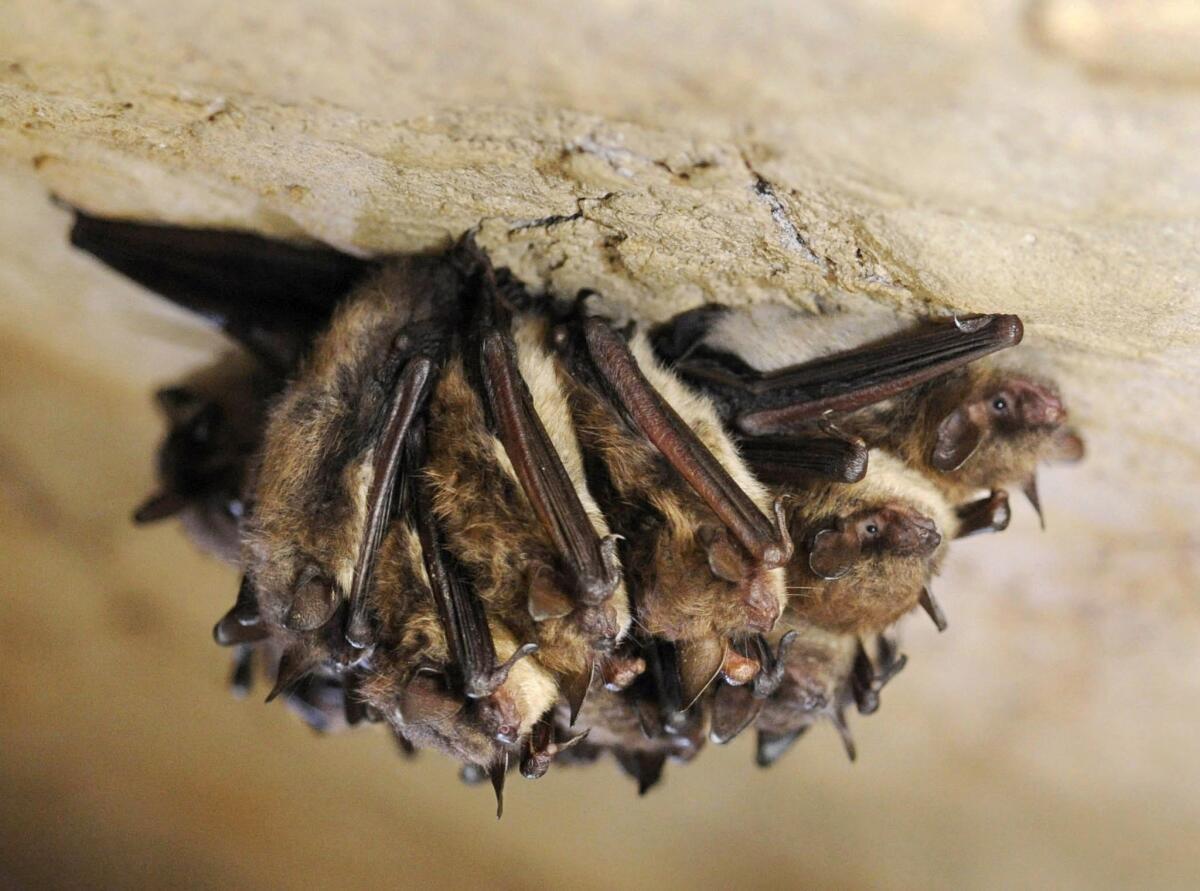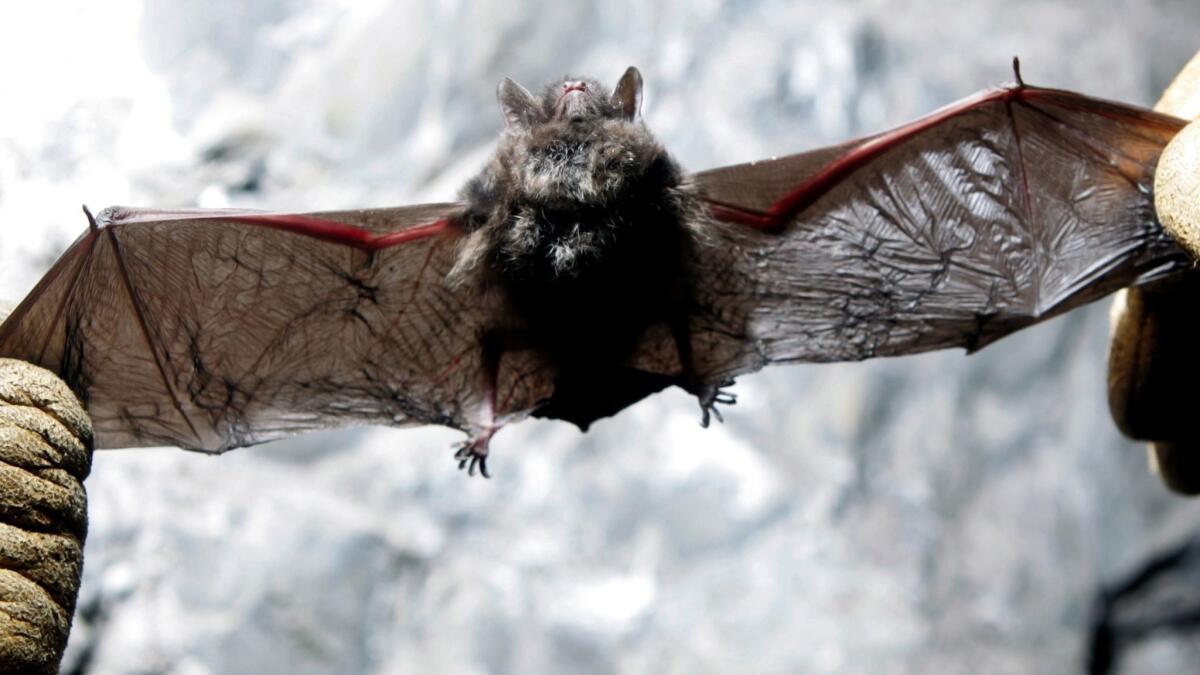A deadly fungus is killing millions of bats in the U.S. Now it’s in California
- Share via
A mysterious fungus that has killed millions of bats in the eastern United States and left caves littered with their tiny carcasses has arrived in Northern California and appears poised to spread throughout the state, according to officials.
Government biologists confirmed Friday that a number of bats found near Lassen Volcanic National Park had tested positive for the germ that causes white-nose syndrome — a relatively new disease that leaves a trademark smudge of white on the infected animal’s muzzle.
For the record:
9:05 a.m. July 9, 2019This article misquoted Miguel Ordeñana as saying he had identified at least five species of bats in the greater Los Angeles area. Ordeñana has identified 12 species of bats in the area.
The illness, which is caused by a cold-loving fungus, appeared suddenly in the Northeast just over a decade ago and has moved steadily west. The fungus has devastated North American bat species in some regions and pushed the natural pest controllers toward extinction.
According to California biologists, the fungus was detected in four bats found roosting within houses and a bank building in the town of Chester, about 15 miles southeast of the park. The first case was detected a year ago, and the others much more recently, officials said.
“We all thought we were going to have more time before it got this far west,” said Winifred Frick, a UC Santa Cruz biologist and chief scientist with Bat Conservation International. “We should all be very concerned about this heartbreaking discovery.”
Since it was first discovered in New York 12 years ago, the fungus has swept across 38 states, and killed legions of bats. A majority of the dead were little brown bats — one of the most common mammals in North America — but scientists say that most of the 45 species of bats in the U.S. and Canada may be susceptible to the disease. (The fungus is not known to cause illness in humans, according to officials.)
The discovery in Northern California was a setback for state and federal efforts to slow the spread of the fungus. Those initiatives have included restricting human access to caves where tens of thousands of bats spend their winters in hibernation, as well as continuing attempts to develop a vaccine.
“There is no silver bullet when it comes to a cure,” Frick said.
Unlike other areas of the country, where bats gather in large numbers, California bats tend to congregate in much smaller groups beneath freeway overpasses, on rocky hillsides, in attics and within the fronds of swaying palm trees.
Although it is possible that warmer West Coast temperatures and smaller groupings of bats could slow the pathogen’s transmission, there is no reason to believe it won’t eventually make its way to Southern California, said Jeremy Coleman, national white-nose syndrome coordinator for the U.S. Fish and Wildlife Service.

“We know the losses of bats in the West will be less conspicuous than in the Northeast, where thousands of dead bats are spilling out of cold, dark caves and across the countryside,” Coleman said. “Beyond that, however, there are a lot of critical unknowns. For instance, we don’t know exactly where bats in California hang out, or how the disease will ultimately manifest in the state’s warmer climate.”
Scott Osborn, statewide coordinator of small mammal conservation for the California Department of Fish and Wildlife, said his agency was filing formal requests for additional funding, staffing and monitoring programs to deal with the pathogen.
“We’re hoping that its impacts in California won’t be as lightning fast and drastic as they have been in other parts of the nation,” Osborn said.
The fungus that causes white-nose syndrome, Pseudogymnoascus destrucans, or Pd for short, is named partly for the destruction it has wrought on the nation’s bat population. The fungus digests the skin and wings of hibernating bats, and is believed to have originated in Europe, where bats there evolved a resistance to it.
Once the fungus made its way to North America however, bats had little time to develop an immunity before they were killed in large numbers.
The disease was first documented in a cave near Albany, N.Y., and then began to spread westward along migratory flyways. Initially, the fungus was identified as Geomyces destructans, but was later determined to belong to another genus.
“We knew this was inevitable, but we are dismayed by the speed,” Coleman said of Pd’s spread. “I wish it was science fiction and not reality.”
Scientists are scrambling to find a solution to the epidemic, because bats fill a vital ecological role that also benefits humans.
At night, they feast on mosquitoes — some of which transmit West Nile virus — and they also devour agricultural pests that damage cotton and corn crops. Recent studies estimate that the value of pest control provided by bats each year is at least $3.7 billion nationwide. They also pollinate the agave plant, which is used to make tequila, as well as the saguaro, the state cactus of Arizona.
During that portion of the year when there are no insects to eat, bats must hibernate to survive — and this has allowed the deadly fungus to flourish. During hibernation, a bat’s body temperature drops to the ideal range for fungi to grow, while the bat’s immune system becomes suppressed. Infected bats will wake far more often than they should during hibernation and deplete their life-sustaining fat supply.
Because of the size of bat colonies and the many ways in which they interact — reproduction, hibernation, swarming, mother and pup activities — it would take only one infected bat to start a local epidemic.
The fungus can persist in cave environments for decades even in the absence of bats. It is usually transmitted through direct contact, but spores can cling to clothing, footwear and caving gear and in this manner, humans can unwittingly transport the spores to new locations.
Scientists have considered using fungicides to fight the disease, but studies have shown they could kill other microbes in caves, perhaps setting off a chain of unintended consequences. Another option — placing heaters in caves — would disrupt bat hibernation, those studies found.

Another plan that was ultimately dismissed as being too impractical was using decommissioned military bunkers as artificial hibernation chambers for wintering bat populations. Temperature-controlled bunkers — which could be decontaminated in the summer — would have enabled biologists to monitor behavior and administer possible treatments for the disease.
A more recent idea that holds promise would be to spray a jelly-like vaccine onto the skin of hibernating bats. The naturally fastidious groomers would consume the medicine as they licked each other’s faces and ears. Officials said it will take several years, however, to develop a viable vaccine.
Ironically, white-nose syndrome’s arrival in California comes at a time when local naturalists are taking increasing notice of the chocolate-brown, mouse-sized insectivores.
Armed with electronic bat detection devices, Miguel Ordeñana, a mammal expert at the Los Angeles County Museum of Natural History, recently confirmed at least five species of bats in the greater Los Angeles area. He has spotted them “flying over every neighborhood in the region — from South Los Angeles and the San Fernando Valley to El Segundo and downtown,” he said.
The most common bat in the Los Angeles area is the Mexican free-tail bat, which gets its name from a quarter-inch-long tail that extends beyond the edge of its tail membrane. The bat has a wingspan of 8 to 10 inches, flies high and fast, and eats moths and other insects.
“Judging from the results of my surveys, local bats are doing better than we thought,” Ordeñana said.
But the discovery of the fungus has suddenly added a sense of foreboding to summer evening “Bats and Brews on the River” strolls along a stretch of the Los Angeles River north of downtown. The public events sponsored by the nonprofit Friends of the Los Angeles River aim to introduce participants to the rhythms of bat life in the vicinity of their own backyards.
“Our goal is to excite and inspire people about the remarkable creatures that share the air space over our urban ecosystem every night,” said Michael Atkins, a spokesman for FoLAR. “The sadness would be to have to say 10 years from now, bats used to be everywhere.”
More to Read
Sign up for Essential California
The most important California stories and recommendations in your inbox every morning.
You may occasionally receive promotional content from the Los Angeles Times.











